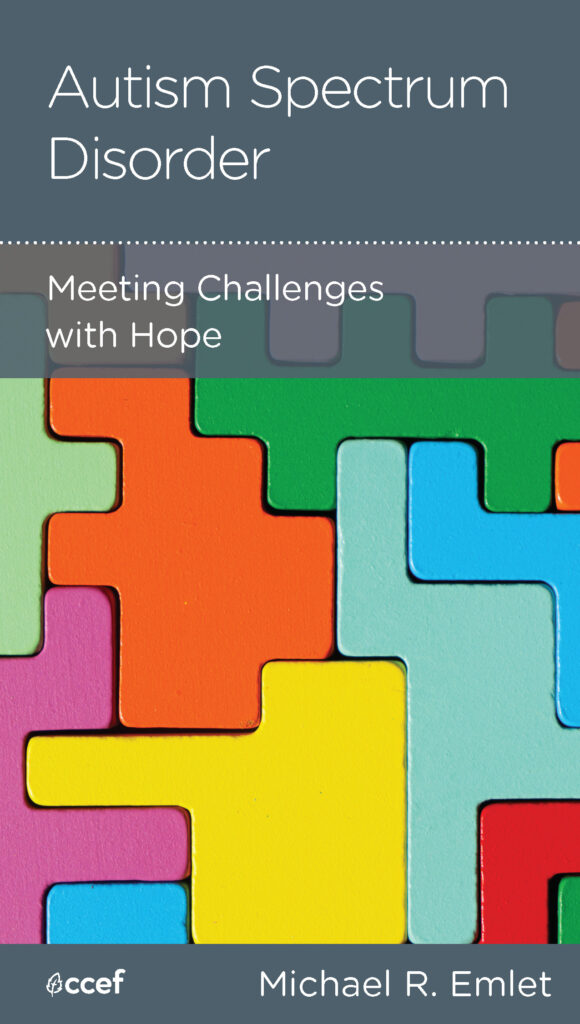Autism spectrum disorder is one of several neurodevelopmental disorders, a group of conditions with their onset early in childhood. The disorder is “characterized by developmental deficits or differences in brain processes that produce impairments of personal, social, academic, or occupational functioning,” as described by the Diagnostic and Statistical Manual of Mental Disorders (DSM-5-TR).1 Some authorities estimate that the prevalence of those experiencing ASD could be as high as one in forty-four children in the United States.2 Taking into account both children and adults, the prevalence of ASD in the United States is estimated to be 1 to 2 percent of the population.3 ASD is much more commonly diagnosed in boys than in girls.
What does this mean for the Christian community? We must thoughtfully and compassionately apply a biblical worldview to serve the substantial numbers of children and adults diagnosed with ASD. Our approach must carefully consider the differences between behaviors related to ASD and behaviors related to heart issues found in most children.
Key Features of Autism Spectrum Disorder
Let’s consider the typical experiences of those on the autistic spectrum.4 Individuals with ASD vary significantly in their level of impairment and need for support in daily life. For the purposes of this minibook, I will focus particularly on individuals who have acquired language, do not have intellectual impairment, and do not require a high level of support. Prior to publication of the DSM-5 in 2013, these individuals may have been diagnosed with Asperger Syndrome. They share some distinctive challenges, including social interaction and communication difficulties, restricted and repetitive behaviors, interests, and activities, and the possibility of other features associated with ASD.
Social interaction and communication difficulties
People with ASD have persistent deficits in social interaction and communication, which make it difficult for them to maintain good relationships, particularly with peers.
Social-emotional reciprocity
Children and adults with ASD struggle to enter into social interactions, and when they do, they find it difficult to have a normal back-and-forth conversation. Even children who have acquired expressive language abilities struggle to use these abilities appropriately in conversation. The ASD literature calls this pragmatic language impairment, or problems in the way language is used socially. A child uses language to communicate the things he knows, but he doesn’t know how to enter into the give-and-take of normal conversation. His communication is informational, not relational. Older children and adults with ASD often struggle with anxiety in novel social situations, having to consciously navigate with great effort what most people find socially intuitive.
Those with ASD often struggle to connect with the interests and emotions of others. They have difficulty understanding and relating to the feelings of others. This does not mean that they have no feelings. They have them, but they struggle to integrate them with what others may be feeling in the moment. This explains why those with ASD might unwittingly hurt others by honest (but tactless) comments, even as they deeply feel the obvious rejection of their peers.
Nonverbal Communication
Children and adults with ASD have trouble expressing and interpreting nonverbal forms of communication, such as eye contact, facial expressions, body postures, and gestures. They may understand someone’s words but miss the message because they do not pick up on subtle nonverbal cues that signal anger, irritation, or amusement in others.
Those on the autistic spectrum also struggle to integrate and coordinate nonverbal communication with speech. They may speak fluently but have poor eye contact or “wooden” body gestures. Or they may use gestures appropriately while their speech lacks prosody (intonation, rhythm).
Developing and Understanding Relationships
People on the autistic spectrum struggle to understand the way relationships work. They may show little interest in making friends and tend to prefer solitary activities. They find it difficult to adjust their behavior to match various social contexts. A child’s honesty with someone who is a committed friend and understands ASD may not lead to hurt feelings. But that same level of honesty with a new acquaintance may be quite off-putting. As a result, they struggle to develop and maintain relationships, particularly with peers.
Those with ASD may have difficulty discerning the various ways language is used. They may struggle to understand figures of speech that are layered with meaning beyond the words themselves. Autistic individuals may not understand certain jokes or subtle humor (irony, sarcasm), which increases their social isolation.5
Restricted and repetitive behaviors, interests, and activities
Restricted and repetitive behaviors, interests, and activities make up a second major aspect of ASD that includes the following features:
Repetitive motor movements, use of objects, or speech
Repetitive physical movements, such as rocking, hand flapping, or finger flicking (sometimes called “stimming”) are common.6 Also characteristic is the repetitive use of an object (lining up toys, spinning a coin) or the repetitive use of language, such as echolalia (the parroting back of heard words) and stereotyped use of phrases. An autistic young man at our church would often come up to me and exclaim, “Mike Emlet!” then walk away, rather than engage in a more typical greeting.
Insistence on sameness
Children with ASD often demand adherence to the same routine (e.g. same breakfast cereal, same route taken to school). They may demonstrate inflexibility to even small changes by manifesting anxiety, argumentative behavior, or in younger children, outright tantrums. Not surprisingly, they commonly have difficulty with transitions from one activity to another.
Intense focus on a particular interest
The special interests of a child with ASD are “highly restricted, fixated interests that are abnormal in intensity or focus.”7 In younger children this could be an unusual preoccupation with a piece of string or a can opener. These focal interests seem to provide a place of enjoyment, mastery, and control in a hard-to negotiate world.8 Unfortunately, especially as children grow older, these intense interests are also frequent obstacles in relationships with others.
Unusually high or low reactivity to sensory input from the environment
Autistic individuals may have an unusually intense reaction to certain sights, sounds, smells, tastes, or touches. Sometimes they have less reactivity to certain sensations, including pain. They may also be fascinated with sensory phenomena, such as flashing lights or the repetitive mechanical movements of a particular object.
Children with ASD often have difficulty filtering out background noise to listen to a conversation. While most children can tune out the hum of the air conditioner or singing from another classroom, the autistic child struggles to do so. Every sound competes equally for attention. This reality can be associated with distractibility, anxiety, or outright meltdowns.
Other associated features
ASD may also come with additional challenges, including the following:
Intellectual and/or language impairment
Individuals on the more severe end of the autistic spectrum may have intellectual impairment, or at least, an uneven intellectual profile (e.g. poor verbal skills but stronger nonverbal skills). Language development in autistic individuals ranges from completely nonverbal to phrase only to fluent speech.
Motor clumsiness
Clumsiness can increase social isolation because it keeps autistic children from playing well in games or team activities in school.
Executive function deficits
Children with ASD tend to have problems planning and carrying out tasks with multiple steps. A parent who says “Get ready for church” may mean for the child to go upstairs, brush their teeth, choose a nice shirt and pants, get dressed, and come back downstairs. Meanwhile, to the child with ASD, such a request may be overwhelming. Where does one begin? What is involved? It might even precipitate a tantrum because the single command represents a series of activities that may be hard to conceive and prioritize. This may also be why it is difficult for autistic children to “shift gears” from one activity or topic to another. Auditory processing struggles may exacerbate this weakness.
1. American Psychiatric Association, Diagnostic and Statistical Manual of Mental Disorders, 5th edition, Text Revision (Washington, D.C.: American Psychiatric Association, 2022), 35.
2. Centers for Disease Control and Prevention, “Data and Statistics on Autism Spectrum Disorder,” March 2, 2022, https://www.cdc.gov/ncbddd/autism/data.html.
3. DSM-5-TR, 62–63.
4. See DSM-5-TR, 56–68.
5. See Grant Macaskill, Autism and the Church: Bible, Theology, and Community (Waco, TX: Baylor University Press, 2019), 19-20.
6. The Warren Center, “What Is Stimming and How Can I Help My Child?” (Richardson, Texas), https://thewarrencenter.org/help-information/autism/what-is-stimming-and-how-can-i-help-my-child/.
7. DSM-5-TR, 57.
8. Patricia Romanowski Bashe and Barbara L. Kirby, The O.A.S.I.S. Guide to Asperger Syndrome (New York: Crown Publishers, 2001), 43.
Excerpted from Autism Spectrum Disorder: Meeting Challenges with Hope © 2023 by Michael R. Emlet. Used with permission of New Growth Press. May not be reproduced without prior written permission.
Autism Spectrum Disorder: Meeting Challenges with Hope
Autism spectrum disorder (ASD) is one of several neurodevelopmental disorders that can cause developmental deficits or differences in brain processing that impair a person’s functioning in many different settings. ASD in the United States is estimated to affect at least 1 to 2 percent of the population. How can we as Christians minister well to those who exhibit the struggles typical of this condition?






